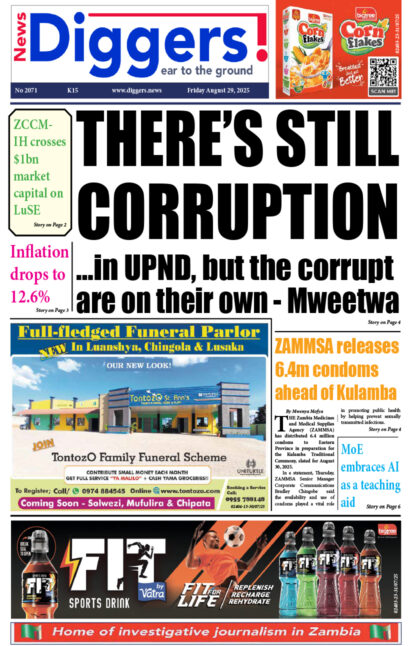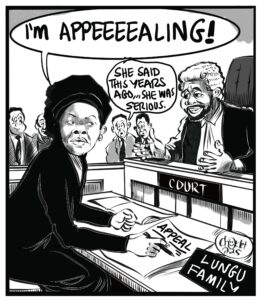Zambia’s liquidity risk has increased due to the substantial drawdown in its international gross reserves, says NKC African Economics.
And NKC, the SA-based think tank, has projected that government’s arrears owed to suppliers and contractors will continue escalating throughout next year, compounding Zambia’s liquidity squeeze.
Meanwhile, the country’s power crisis is likely to worsen throughout 2020, possibly into 2021, despite planned electricity generation projects due to come on-stream.
In a country quarterly update released, Friday, NKC stated that the country’s liquidity risk had increased in the latter part of this year due to the substantial drawdown in its international gross reserves, triggered by ongoing external debt servicing.
Government, through the BoZ, usually resort to utilizing the country’s international gross reserves, which had plummeted to a 10-year low of US $1.43 billion, representing just 1.6 months of import cover, to service external debt payments.
“In terms of risk, Zambia in our view recorded a substantial deterioration on both a quarter-on-quarter and year-on-year basis. Our quantitative analysis rests upon four pillars of risk, namely: political, economic policy, economic structure and liquidity risk. Liquidity risk has increased both on an annual and quarterly basis due to a sharper-than-expected drawdown of the foreign reserve buffer, which will require additional external debt in order to continue timely debt servicing and much-needed emergency power imports. Export receipts will remain inadequate to meet external obligations, requiring a further drawdown of the fragile foreign reserve,” the Report, jointly-authored by NKC’s senior financial economist Irmgard Erasmus and senior political analyst Gary van Staden, stated.
“We consider economic policy risk to have weakened over the past quarter due to weak credit expansion, while high commercial rates threaten further deterioration in asset quality as debtors struggle to meet payments. In addition, a weakening inflation outlook, elevated risks of monetary instability, a fragile exchange unit and uncertainty related to foreign capital contributed to deteriorating economic policy risk. The latter relates to weaker relations with multilateral organizations, concerns of resource nationalism and risk of a drift towards populist policies. These factors compound challenging business conditions attributable to extended power outages and higher operational costs. That said, severe financial strain and hard currency challenges may quicken progress towards privatization of state-owned entities.”
And NKC projected that government’s arrears owed to suppliers and contractors would continue escalating throughout next year, compounding Zambia’s liquidity squeeze.
Government’s arrears owed to contractors and suppliers swelled to K16.7 billion as at March 31, 2019, from K15.6 billion by the end of last year.
“We retain a more conservative forecast on the current stock of outstanding arrears (9 per cent of GDP) than the IMF (7 per cent of GDP) with a high probability to worsen in the period through mid-2020. The significance of this assumption lies in the spillover effects to the real economy: cash-drought may further introduce downward risks to meeting the already-optimistic revenue target for 2020, threatening increasing non-payment of government obligations. A build-up in the stock of arrears contributes to low money in circulation, which could further crowd out private sector consumption and investment,” it stated.
“The build-up of arrears – we estimate that arrears rose from 5.6 per cent of GDP in 2018 to 9 per cent of GDP this year – contributed to the ongoing liquidity squeeze, hampering business activity and undermining confidence. We foresee only a gradual dismantling of arrears, more conservative than even the pace that the IMF envisions with the stock of arrears forecast to stand at 6.7 per cent of GDP by 2023 and 5.5 per cent of GDP by 2025.”
Business conditions are equally expected to deteriorate even further on the back of the power deficit, which was sharply felt in the second part of this year.
“Business activity is forecast to deteriorate considerably in the period through 2020 Q1. An escalation in inflation and deepening liquidity drought are seen as overturning modest progress noted in October’s PMI figures, and we specifically expect business confidence to hit multi-year lows before December to pause purchasing activity momentum,” it stated.
Meanwhile, Zambia’s power crisis is forecast to worsen throughout next year, possibly into 2021, despite planned electricity generation projects due to come onstream, amidst the ongoing drought conditions and government’s continued fiscal challenges.
“Kariba Lake levels dropped from 17 per cent full at end-September to 13 per cent usable storage by end-October, compared to 66 per cent full the previous year. The worsening power crisis, which we initially expected to be alleviated by February/March 2020, is now seen as persisting deep into 2020 with a high risk of spilling over to 2021, an election year,” read the Report.
NKC African Economics is a South African-based think tank owned by Oxford Economics.
























